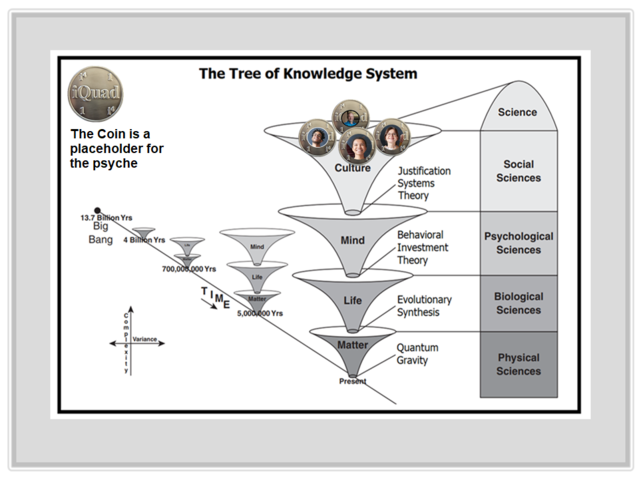Psychology
How Can We Define the Psyche?
Scientific psychology is the outside-in view. The psyche is the inside-out view.
Posted March 4, 2022 Reviewed by Tyler Woods
Key points
- The science of psychology is an outside-in view of mental behavior that is concerned with generalizable descriptions and explanations.
- The psyche is an inside-out view from the subject located in the real world.
- The Unified Theory of Knowledge can effectively place the outside-in view of science in relation to the inside-out view of the psyche.
- In the UTOK, the Tree of Knowledge System maps the science view, whereas the iQuad Coin is a placeholder for the psyche.
My book, A New Unified Theory of Psychology1, barely mentions the psyche. Indeed, it only offers two passing references to it, and it does not define the term at all. In contrast, many pages are spent defining exactly what is meant by the science of psychology, and its core terms like behavior, mind, cognition, consciousness, and the self. This raises a key question: What is the relationship between the science of psychology and the psyche?
At the time of writing that book, in 2011, I would have justified the absence of focus on the concept of the psyche by claiming that, although the term has an important historical role to play in the field, it is ambiguous. Moreover, I would have stated that its historical meaning does not fit with the language game of modern empirical natural science. I am still in agreement with the latter part of this statement. However, over the past year or so, I have come to see that the psyche is a crucial term, and it is one that can now be well-framed by the Unified Theory of Knowledge (UTOK). Toward that end, I have put together a new cognitive science show with John Vervaeke and Garri Hovhannisyan, called Psyche-pathology and Well Being, that delineates this new formulation. We just released the first episode of that series, and the second episode will be released today.2

Somewhat ironically, it turns out that the key to understanding what the psyche references is to clearly differentiate it from the subject matter of modern scientific psychology. According to the UTOK, modern science is a knowledge system that tracks patterns of behavior that are observable from an exterior epistemological position3. This means that if psychology is going to be a science in the modern, natural, empirical sense of the word, it, too, must work to describe and explain behavior. According to the UTOK, this can be achieved. Specifically, we can frame the subject matter of scientific psychology as being concerned with animal-mental behavior in general. In addition, the science of human psychology is concerned with human mental behavior, which is an important and unique subset. This is because human mental behavior is a function of us being both primates (and thus operating at the animal-mental dimension called “Mind”) and persons (and thus operating at the Culture-Person plane of existence, which is structurally and functionally framed by systems of what is and ought to be)4.
The UTOK metapsychology allows us to clearly map these patterns of behavior via the descriptive metaphysical systems provided by the Tree of Knowledge System, the Periodic Table of Behavior, and the Map of Mind1,2,3. These frameworks allow us, for the first time in the history of modern science, to clearly define what we mean by “the science of behavior and mental processes.” This is because, as this essay makes clear5, these metaphysical frames allow us to be clear about the ontology of the science of psychology. This means that the UTOK gives rise to a whole new approach to scientific psychology. Specifically, it allows us to make a fundamental shift from the current “methodological behaviorism” that defines mainstream academic psychology (i.e., psychology is a science because it applies the methods of science to behavior and mental processes) to a much more advanced “mental behaviorism” that specifies the kind of behaviors in the world that psychology is concerned with (i.e., psychology is the science of animal and human mental behavior because those are the kinds of behaviors psychology is tasked with scientifically describing and explaining).
Ultimately, the task of science is to create generalizable “laws” or “habits” that afford a coherent description of patterns of behavior in the world into a causal explanatory framework. Toward this end, the UTOK offers Behavioral Investment Theory, the Influence Matrix, and Justification Systems Theory to afford us metatheoretical frameworks that align the key insights from the major schools of thought to form a coherent causal explanatory framework for understanding the patterns of human mental behavior. This means that, when these metatheoretical frameworks are combined, the metaphysical systems given by the ToK System, Periodic Table of Behavior, and Map of Mind, we now have a complete system that effectively gets the ontology of scientific psychology's subject matter correct. In addition, as the series of cognitive science shows on consciousness6, the self7, and metapsychology8 now makes clear, the UTOK syncs up directly with John Vervaeke’s 4P/3R metatheory of cognition. This synthesis allows us to have much confidence that we are putting the puzzle pieces in the right places.
Whereas the above analysis allows for a unifying framework for the science of psychology, it also leaves open a key variable. This is the position of the specific, particular, unique, contingent, embodied, qualitative “real” subject in the world. The reason that science is blind to this variable is because it is a theoretical, descriptive, causal explanatory map of the territory (i.e., the real), and it is epistemologically positioned from the outside in. In contrast, the position of the real individual situated in the world is from the inside out. Moreover, that experience is local, idiographic, and not available to intersubjective observation. It is this first-person experience of being in the world that works as the referent for the psyche. The UTOK metapsychology has a framework for holding the psyche called the iQuad Coin9. As suggested by this depiction, it works with the Tree of Knowledge System to advance a clear picture of how we can bridge a naturalistic scientific view of cosmic evolution with each of our individual psyches, represented as our faces on the Coin.

To summarize, the science of psychology is anchored to the modern empirical natural science enterprise. This enterprise is committed to an exterior epistemology that frames the behavior patterns in the world. In contrast, the psyche is a different kind of thing. It refers to the first-person experience of being in the real world. It is an epistemological portal that can be framed as the entity that observes. It can only be directly observed or experienced from the inside out and cannot be observed via modern science’s exterior epistemological position, which is anchored to an intersubjective, objectivist empiricism. In short, the science of psychology is an outside-in epistemic vector that provides general maps of mental behavior patterns, whereas the psyche is an inside-out epistemic vector of specific, qualitative subjects in the real world.
This analysis further suggests that we can reframe the so-called hard problem of consciousness10 in terms of the hard problem of the psyche. It further suggests that we now have an emerging metatheoretical synthesis that is up to the task of framing both the outside-in epistemic vector given by the science of human psychology (framed by the ToK system, and the BIT, Matrix, JUST, and 4P/3R metatheories) and the inside-out epistemic vector of our personal "psyche-ologies." The reason is that the UTOK frame gets the metaphysics, ontology, and epistemological issues correct, and it gives rise to a metatheoretical causal explanatory framework that aligns between the general, scientific behavioral outside-in and personal, qualitative inside-out epistemic vectors. The hope is that, together, these insights may culminate in something that moves us toward a second scientific Enlightenment, one that gives rise to a naturalistic ontology that can revitalize the human soul and spirit (a.k.a., the psyche) in the 21st Century.
References
1. Henriques, G. R. (2011). A new unified theory of psychology. New York: Springer.
2. Vervaeke, J., Henriques, G., and Hovhannisyan, G. (2022). Psyche-pathology and well-being. A Cognitive Science Show production.
3. Henriques, G. (2021). Does the concept of behavior unify all of science? Theory of Knowledge blog post on Psychology Today.
4. Henriques, G. (2017). Our two essences: Modern humans as primates and persons. Theory of Knowledge blog post on Psychology Today.
5. Henriques, G. (2021). A new approach to the science of psychology. The Unified Theory of Knowledge blog on Medium.
6. Vervaeke, J, & Henriques, G. (2020). Untangling the world knot of consciousness. A Cognitive Science Show production.
7. Vervaeke, J, & Henriques, G., & Mastropietro, C. (2021). The elusive "I": The nature and function of the self. A Cognitive Science Show production.
8. Vervaeke, J, & Henriques, G., & Stein, Z. (2021). Toward a metapsychology true to transformation. A Cognitive Science Show production.
9. Henriques, G. (2021). The iQuad Coin Blog Series, Part I: Linking the human identity function to the complex unit circle. A Unified Theory of Knowledge blog on Medium.
10. Henriques, G. (2019). There are two hard problems of consciousness, not one. Theory of Knowledge blog post on Psychology Today.


